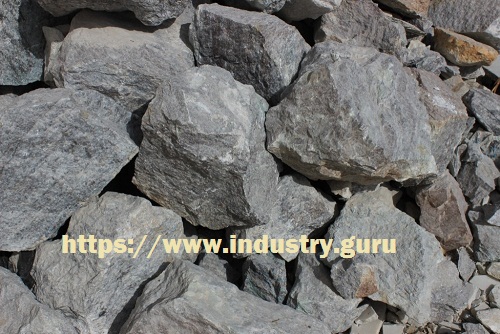25-July-2020
Kyanite which is an aluminium
silicate with chemical formula Al2SiO5, belong to the Sillimanite
group of minerals comprising Sillimanite, Kyanite, Andalusite, Dumortierite and
Topaz. Kyanite is an important raw material for high alumina refractories. Especially,
Raw
Kyanite is extensively used for making high alumina insulation Refractory
Bricks.
Apart
from refractory industry kyanite particularly its blue variety, is also used as
gem stone. The kyanite gem stone is believed to possess certain metaphysical
properties with its ability to keep the mind calm and anxiety under control.
The name Kyanite was derived from the Greek word Kyanos which means blue.
Mineralogy of Kyanite
 |
| Raw Kyanite (Lumps) |
Kyanite
is found as subhedral and tabular to elongated, thin, bladed crystals having
blue or light-green colour in the form of crystalline aggregates in schists,
gneisses, granite pegmatite and occasionally in eclogites. The crystal system
is Triclinic; optically kyanite is colourless and feebly pleochroic from pale-blue
to colourless with one set of perfect cleavage, first and second order
interference colour (yellow, grey and blue). The distinguishing features of
kyanite are its higher refractive index than those of Sillimanite and
Andalusite while birefringence is lower. The oblique extinction angle up to 32O
together with the biaxial interference, negative optic sign, and large
optic axial angle are also distinctive for kyanite. Its hardness varies from 4
to 7 (Moh’s scale) and specific gravity is around 3.6 - 3.7.
Indian Occurrences
In the
Indian subcontinent very good gem quality kyanite is found Nepal.
Kyanite
is formed at medium temperatures and high pressures in a regionally
metamorphosed sequence of rocks and is found associated with minerals like -
muscovite, quartz, garnet, staurolite and rutile. Kyanite is also found as
detrital mineral. For the Use of Kyanite in Refractory Industry the Directorate
General of Technical Development (DGTD) has recommended the following
specification:
Grade-I
|
Grade-II
|
Grade-III
|
|
Al2O3
(min)
|
58%
|
54%
|
46-48%
|
Fe2O3
(max)
|
1.5%
|
1.5%
|
2%
|
PCE
(min)
|
37
(Orton)
|
37
(Orton)
|
Suggested Article: Use of Kyanite as Refractory Raw Material
Recoverable
reserves of medium to high grade kyanite in India and the current trend of
production-utilization causes serious concern because of dwindling availability
of this mineral in India. During 1960’s the hard, massive, lumpy variety of
kyanite with Alumina content more than 61% and Iron content around 0.8% of Lapsa Buru mines in Kharswan (Bihar) was
the largest deposit in the world. Today the source has dried up. Only poorer
quality is now available which cannot be used as such. Deposits of kyanite
available in a few other places some of which are being mined and supplied at
present are -
Chemical Compositions of Indian Kyanite deposits
SiO2
|
Al2O3
|
Fe2O3
|
TiO2
|
CaO
|
MgO
|
Na2O + K2O
|
LOI
|
|
Lapsa
Buru (Bihar)
|
34.8
|
61.1
|
0.5
-1.3
|
--
|
0.2
-0.3
|
0.2
|
--
|
0.5
|
Singhbhum
(Jharkhand)
|
46.5
|
45.97
|
0.5
|
1.5
|
--
|
--
|
--
|
1.1
|
Kudineerkati
(Karnataka)
|
40.32
|
58.15
|
1.7
|
Tr.
|
0.52
|
--
|
--
|
1.32
|
Sulia
(Karnataka)
|
32.8
|
61
|
1.85
|
2.7
|
--
|
--
|
--
|
1.65
|
Purulia
(West
Bengal)
|
38.8
|
46.65
|
2
|
Tr.
|
--
|
--
|
--
|
1.65
|
Khammam
(A.P.)
|
51.92
|
27
|
11.25
|
--
|
--
|
--
|
--
|
--
|








0 on: "Kyanite - Properties and Indian Occurrences"